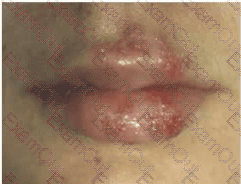A 43-year-old man comes to your office for the first time. He has not seen a doctor in over 5 years and has no known past medical history. On examination, his blood pressure is 120/70 mm Hg, and the remainder of his examination is normal. As part of the initial visit, you order some screening blood work that reveals a fasting blood glucose of 6.3 mmol/L (3.3–5.8) and a hemoglobin A1c of 6.1% (4–6). Which one of the following is the best next step?
A 6-year-old boy is brought to the Emergency Department with a 2-day history of a limp. On examination, he looks well, has a temperature of 38 °C and is able to weight-bear. His hip examination reveals mild decreased range of motion. Radiographs of his hip and pelvis show no abnormality. His C-reactive protein level is 8 mg/L (< 6). Which one of the following is the most likely diagnosis?
A 53-year-old man presents to the Emergency Department with a 3-week history of believing his neighbor is poisoning him by pumping gas through his home’s air vent. He appears distracted, irritable, and is speaking very quickly. He has a family history of depression. Which one of the following is the most likely diagnosis?
A 2.5-year-old boy is brought to the Emergency Department after he consumed a button-shaped battery. Chest and abdomen radiographies are performed. Which one of the following locations mandates urgent removal of the battery?
An 18-year-old man presents to your clinic with a history of intermittent, dull, achy pain on the left side of his scrotum, and he has now noted left scrotal enlargement. On examination, you note a swelling in the left scrotum when he is standing that disappears when he is supine. Which one of the following is the most likely diagnosis?
An investigator interested in the etiology of neonatal jaundice conducted a study where he selected 150 children diagnosed with this condition and 150 children born in the same time period and in the same hospital who did not have a diagnosis of neonatal jaundice. He then reviewed the delivery records of their mothers to determine various prenatal and perinatal exposures. This is an example of which one of the following?
A young man and woman who are in a relationship present to the office for prenatal counselling. During the visit, you observe that the man's lips appear as shown in the referenced photo.

[Image shows grouped vesicular lesions on erythematous base affecting the lips—classic for herpes labialis (HSV-1).]
Which one of the following is the best advice?
A 45-year-old man with a developmental delay and a history of disruptive behavior presents to the clinic looking for his family doctor. He is well known to the clinic. He appears drunk and has accidentally broken 2 large beer bottles in the waiting room but remains calm. The office staff requests your help to deal with this situation. Which one of the following is the most appropriate initial step?
A 30-year-old woman presents to your office with a 6-week history of left lower quadrant pain and dyspareunia. A pelvic ultrasound is normal. Which one of the following is the most important immediate investigation?
A 19-year-old woman returns to your clinic to discuss her recent laboratory tests. She initially presented with dysuria, dyspareunia, and abnormal uterine bleeding. Her vulvovaginal examination was normal. Her last sexual encounter was 3 weeks prior to the onset of her symptoms. Which one of the following pathogens is most likely to explain this clinical presentation?

